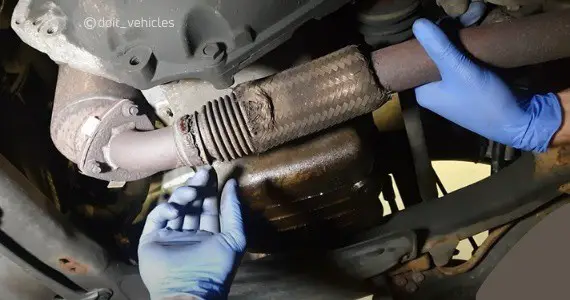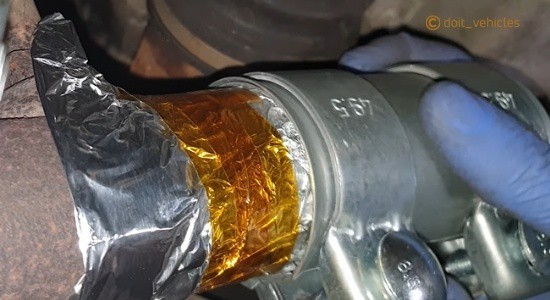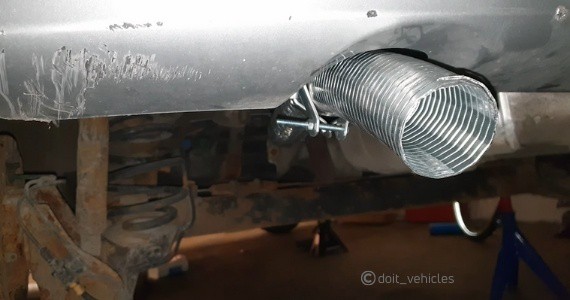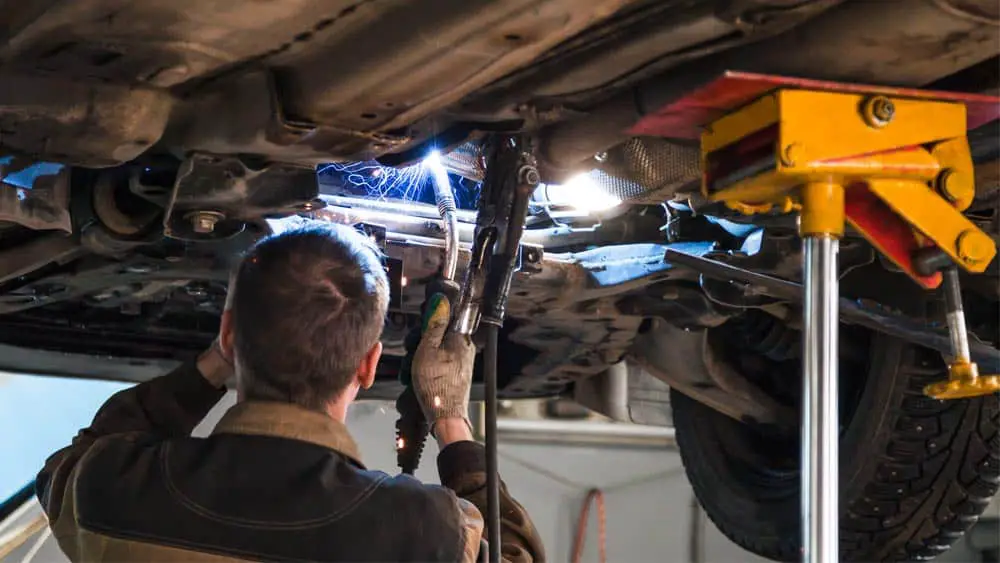An exhaust leak can make you deal with various complexities. If you do not know wherever the precise leak point is, fixing the leak may be trickier than expected. Even if you cannot find the leak, there is a high probability you will realize it is hard to patch without the proper info. Several complicated stuff could stem from a leaky exhaust, which is why you have to pay a great deal of attention. In addition, if there is an emergency, you have to grasp a way to fix an exhaust leak without welding.
Exhaust System
A vehicle’s exhaust system consists primarily of a series of pipes. The majority of people think that an exhaust system only removes the harmful gases created in your vehicle’s engine. However, exhaust systems do much more!
The exhaust system in your vehicle has four main functions:
- Control Noise in Engine,
- Emit Gases,
- Improvement in engine efficiency and
- Improvement in fuel consumption.
Faulty Exhaust System Symptoms
Now, to determine whether there is a leak in the exhaust system or not, you can observe the following:
- The engine will be noticeably noisy. Usually, a hissing or tapping sound arises with a faulty exhaust manifold gasket. The sound increases with a cold start and acceleration.
- The performance of your engine will be highly affected. While using the acceleration you will find out the anomalies.
- Because of power and acceleration decrease, often the fuel efficiency of your vehicle also goes low.
- You can be sure that the condition is worse if there is a burning smell. In this case, it should be checked without any delay to maintain safety.
- Hanging or dragging the exhaust pipe should be fixed immediately.
- The smell of gas is another indicator of a faulty exhaust system.
These are the regular cases of a faulty exhaust system. However, if you are bothered with any other anomalies, you should bring your vehicle to an expert mechanic or to the dealer and have a thorough checkup.
Corrosion of the Exhaust System
The exposure of metals to environmental threats might cause corrosion. Normally, internal combustion engines need water to reduce their temperature. During cold weather, it is a common issue to see vapor from tailpipes.
The water within the exhaust tube can damage your vehicle’s muffler and metallic components. When rust particles within the exhaust systems increase, they will result in an enclosed blockage and poor performance.
This blockage would possibly place some strain on the engine, and scale back its performance. In addition, the sound is another waste material that comes with exhaust leaks. These leaks usually begin by making tiny hisses, and so massive appears like a torn speaker.
Discharging harmful fumes from multiple components of the exhaust system will increase the danger of environmental pollution. Also, these exhaust gases cause a health risk to each passenger and road user.
There might be two types of corrosion:
- Internal corrosion caused by acidic condensate.
- External corrosion caused by de-icing agents used on icy roads.
Fixing Leak of the Exhaust System
Ways of fixing the leak in the exhaust actually depend on the type of the leak. Exhaust leaks are usually two types of categories:
- Blown gaskets, and
- Damaged parts.
If a gasket is blown, fixing the matter is often simply just replacing the faulty gasket. This can be usually the easiest and most cost-effective sort of exhaust leak to fix. However, complicating factors can embody a gasket that is tough to access and a blow that is caused by damaged flanges.
If the exhaust is leaky because of damaged components, the component should be fixed. This might be as simple as welding a puncture hole. It often needs cutting out a bad piece and welding in an exceeding weldingmaniac08-20nt.
If there is merely a rusty or physically broken section of tubing, weldingmaniac08-20nt is fairly simple. Even a muffler is not too tough to switch. If the harm is severe, it is necessary to replace the whole system.
Ultimately, you ought to replace the exhaust system. Your life and the lives of your passengers may depend upon this. The leak in the exhaust may lead to CO (carbon monoxide) entering into the vehicle, thus making you ill or fall asleep while driving.
Most Efficient Way of Fixing Leak of the Exhaust without Welding
Repairing an exhaust pipe without welding could be a straightforward process. But it should be done by someone who’s expert, else should follow the given process carefully:
1. Locating the Leak in the Exhaust
To find the problem, park the vehicle on a firm surface first. However, it is necessary that the surface should bear the vehicle’s weight and elevate it safely. Allow it enough time so that the exhaust pipe will cool down. If the engine is on, the exhaustive tube of your vehicle may be very hot. So, continuously check before touching the pipe. to see if it’s still hot. Touch the hood of your car first. If you feel warmth, then give an additional hour (or more if necessary) for pipe cooling.

2. Jack up the Vehicle and Examine Thoroughly
It is not safe to work under a vehicle that is solely supported by a jack. Use jack stands, or wheel stands below the vehicle to confirm safety. Once up, begin inspecting the exhaust piping thoroughly. Expect the signs of damage similar to scrapes and cracks. You can also notice holes if the damage is bigger. Rust is additionally a common reason behind exhaust leakage.
3. Consider Your Options to Fix
Once you know the reason behind the damage, you have got to consider the most efficient way to repair the faulty exhaust pipe. For example, without the cutting and welding scrapes and holes can be repaired. However, if the pipe is deeply covered with rust, then there is no alternative but to replace it. Even the little holes may be repaired using tape or putty. If the hole is just too large to be mounted by the exhaust tape, then a chunk of aluminum can be sealed with epoxy.
4. Cleaning the Damaged Portion
Get a steel-toothed brush and clean the affected portion of the vehicle’s exhaust pipe. Clean out the mud, dirt, grime, and rust particles, wearing your protective goggles. Then take sandpaper and clean away the remaining bits of dirt to prepare the surface for the repairs. The surface should be cleaned properly for the patches to stick with a stronger bond. After that, use Acetone and wipe out the complete pipe. If Acetone is not available, use any nail polish remover to scrub the surface area.
5. Seal the Damaged Pipe with Patch or a Tape
Using a Patch:
First of all, determine the size of the patch needed according to the damaged portion. Then, cut an aluminum patch to fit over the leak and cover over the area surrounding the leak with epoxy. Place the patch over the leak and apply epoxy over the patch. Finally, secure a large patch in place with hose clamps.

Using a Tape:
With a repair tape, the task can be easier. Firstly, cover the leak with two layers of tape and see whether they sealed the leak properly or not. Also, keep one thing in mind is that different types of tape are used for a totally different applications. Some are often applied on a wet surface, and a few ought to be used on dry surface areas.
Exhaust leaks can cause severe problems in the future if not fixed properly. Such defective items of your car may harm the entire system in no time and might additionally risk the life of the passengers afterward. Therefore, conducting regular inspections and providing your vehicle with better maintenance from time to time is the only way to ensure safety.

Suggested Read:

